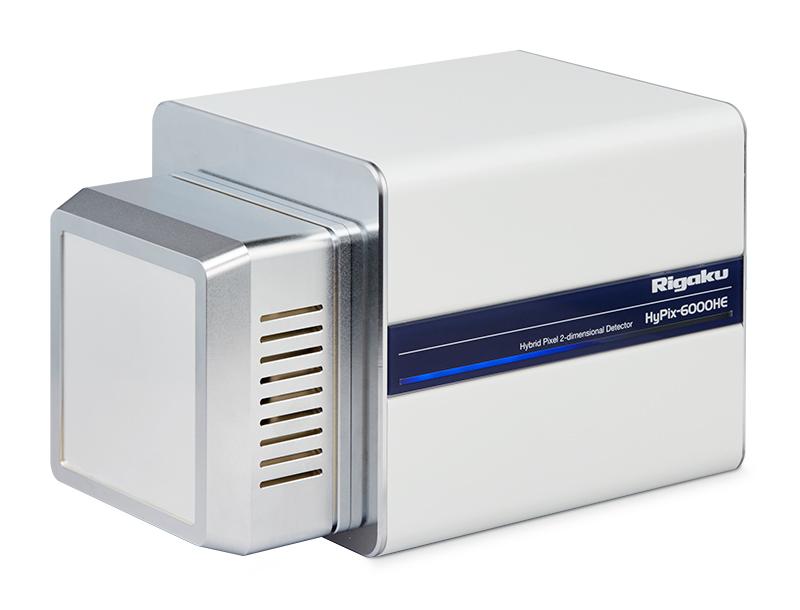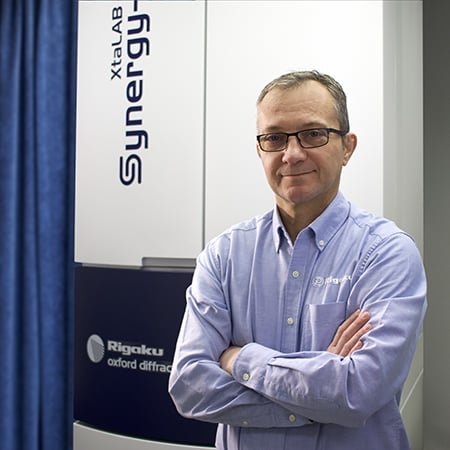HyPix-6000HE
Hybrid Photon Counting X-ray Detector
Large area Hybrid Photon Counting detector for single crystal X-ray diffraction
Rigaku Oxford Diffraction now offers the HyPix-6000HE Hybrid Photon Counting (HPC) detector. Like all HPCs, the HyPix-6000HE offers direct X-ray photon counting for every photon, single pixel top-hat point spread function with no readout noise and no dark noise.

HyPix-6000HE Overview
The 100 micron pixel size allows better resolution of reflections for long unit cells as well as improving reflection profile analysis. The HyPix-6000HE has a high frame rate of 100 Hz, as well as a Zero Dead Time mode providing the ultimate in error-free shutterless data collection.
The advantage of direct detection found in the Hypix-6000HE is that no phosphor is required and the size of the pixel determines the point spread function rather than the blooming that occurs on detectors with a phosphor. This means that reflections are sharper and more easily resolved. Profile analysis will not require incorporating additional pixels to compensate for phosphor blooming leading to less experimental noise, such as air scatter, being incorporated into a reflection. As opposed to monolithic detectors, such as CMOS-based CPADs, a hybrid detector separates the detection area from the read-out electronics. This means that the full area of a pixel is sensitive to incoming X-ray photons, with the charge being transmitted through an indium bump bond to a secondary readout pixel. In APS-CMOS/CPAD detectors, each pixel contains in-pixel readout electronics that come at the expense of light sensitive area. Monolithic detectors used in crystallography often have a 30% dead area or detection-gap per pixel that occurs through the whole detector.
The HyPix-6000HE is the perfect detector for measuring diffraction from small and poorly diffracting samples due to the extremely low noise characteristics: you can count as long as you need to without the dark current or noise build up seen in other detectors. When your crystals diffract well, the high frame rate and Zero Dead Time mode mean that you can collect data extremely fast and accurately in a shutterless mode.
The HyPix-6000HE is air-cooled for convenience. Unlike an integrating detectors, there is no dark current build up from thermal electrons so high temperature stability is not needed. Lower efficiency and less stable air cooling is therefore not detrimental to data quality measured with HPC detectors.
HyPix-6000HE Features
HyPix-6000HE Videos
HyPix-6000HE Specifications
| Technique | Single crystal X-ray diffraction | |
|---|---|---|
| Benefit | Fast, sensitive digital X-ray photon counting detector | |
| Technology | Hybrid Photon Counting (HPC) X-ray detector | |
| Attributes | Air-cooled HPC detector | |
| Computer | External PC, MS Windows® OS, CrysAlisPro Software | |
| Dimensions | 137 (W) x 143 (H) x 216 (D) (mm) | |
| Mass | 3.8 kg (core unit) | |
| Power requirements | 1Ø, 100-240 V, 15 A | |
HyPix-6000HE Application Notes
The following application notes are relevant to this product
-
PX021 - I-SAD Phasing of the HIV Integrase Core Domain using Data Collected on the XtaLAB Synergy-S
-
SMX019 - The HyPix-6000HE Detector and Its Ability to Resolve Reflections at Close Crystal-to-Detector Distances
-
PX015 - Data Collection and Improved Spot Resolution with the HyPix-6000HE HPC Detector
-
SMX038 - Rigaku Rotating Anodes: Powerful and Reliable Sources for Seamless and High-throughput Small Molecule Structure Solution
-
PX028 - Resolving Large Unit Cells by using the Correct Detector, Distance, and Beam Divergence
-
PX024 - Lysozyme S-SAD Phasing with Two Minutes of Data Collection on the XtaLAB SynergyCustom
-
PX022 - Thaumatin S-SAD Phasing with 2 hours of Data Collection on the XtaLAB Synergy-S
-
SMX017 - Determining Structure of Volatile Compounds with the Crystalline Sponge Method
-
SMX036 - Comparison of Two XtaLAB Synergy Instruments
-
PX023 - ClpS SAD phasing with 30 Minutes of Data Collection on the XtaLAB Synergy-S
-
SMX023 - Charge-density Data Collection on XtaLAB Synergy-S with HyPix 6000
-
SMX024 - Charge-density Data Collection on XtaLAB Synergy Diffractometers
-
SMX028 - Calibrating the XtaLAB Synergy-S for PDF Analysis
HyPix-6000HE

Contact Us
Whether you're interested in getting a quote, want a demo, need technical support, or simply have a question, we're here to help.
